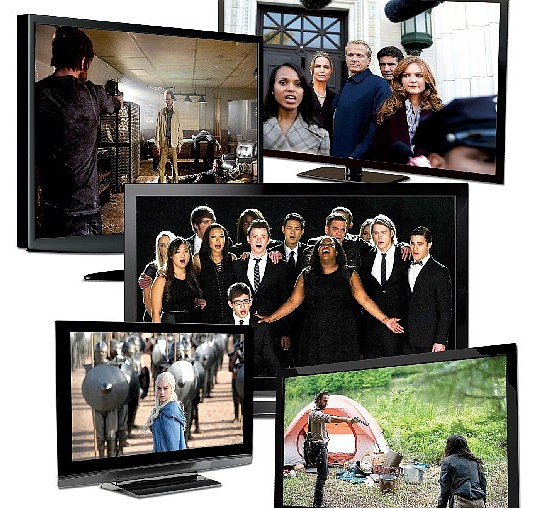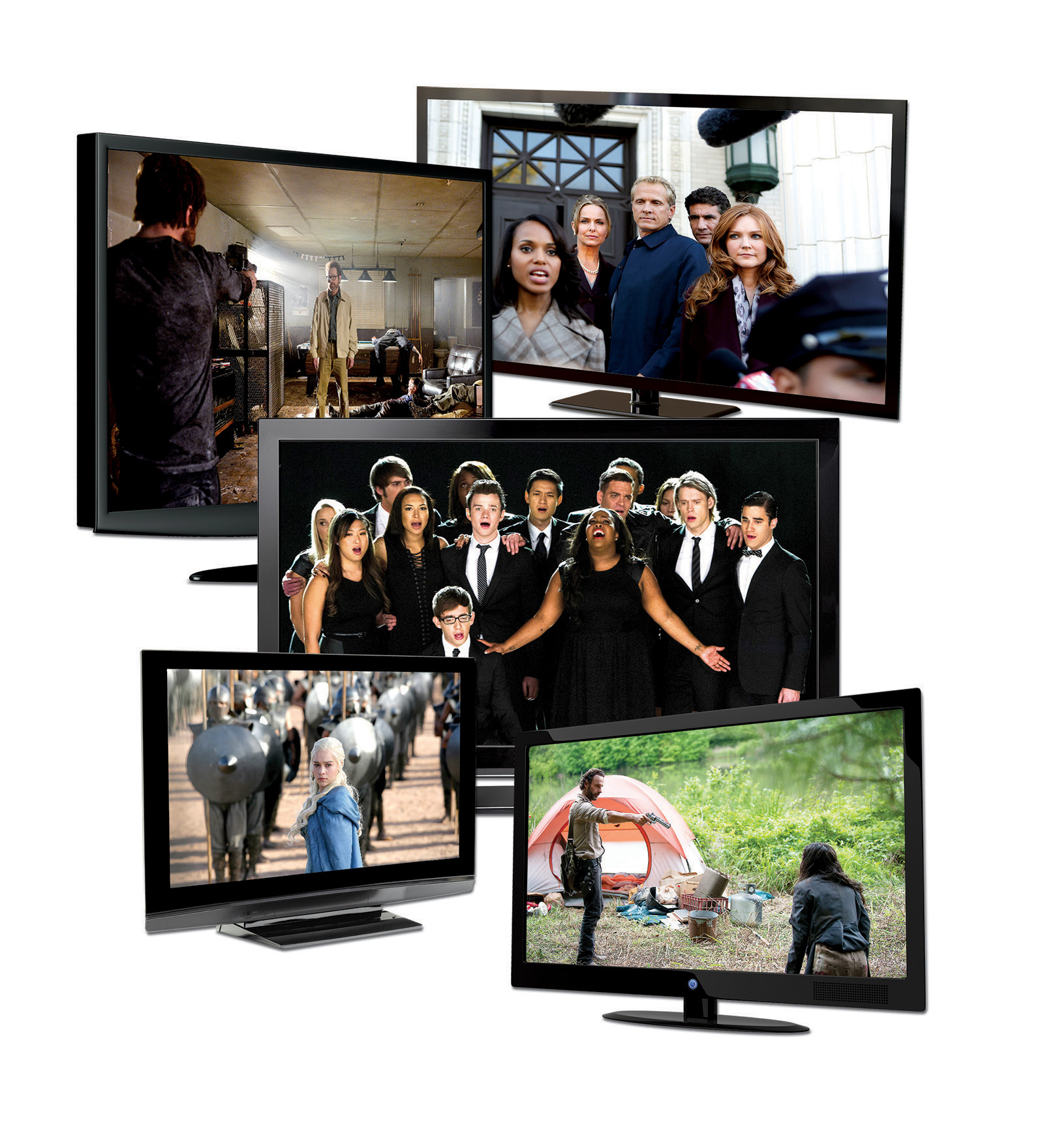WHAT ABOUT FACEBOOK?Facebook also has recognized the value of tracking live TV chatter from its 1.2 billion users, about six times Twitter's 218 million. According to Associated Press writers Barbara Ortutay and Ryan Nakashima, the "Breaking Bad" finale generated more than 5.5 million "interactions" such as status updates, comments or "likes."THE RANKINGSMedia research group Nielsen has begun tracking the link between TV ratings and chatter about episodes on Twitter. In August, Nielsen-owned SocialGuide began tracking Twitter activity across 239 channels and now releases weekly charts showing the most active online community, including the scope of the audience reached by the relevant Tweets.Here is the list from the week of Oct. 7-13:1. "The Walking Dead" (Oct. 13)Network: AMCUnique audience: 7.49 million viewsTwitter activity: 1.2 million Tweets2. "Glee" (Oct. 10)Network: FOXUnique audience: 5.17 million viewsTwitter activity: 822,000 Tweets3. "American Horror Story: Coven" (Oct. 9)Network: FXUnique audience: 4.62 million viewsTwitter activity: 435,000 Tweets4. "Catfish: The TV Show" (Oct. 8)Network: MTVUnique audience: 3.54 million viewsTwitter activity: 743,000 Tweets5. "The X Factor" (Oct. 9)Network: FOXUnique audience: 2.40 million viewsTwitter activity: 423,000 Tweets6. "Scandal" (Oct. 10)Network: ABCUnique audience: 2.13 million viewsTwitter activity: 328,000 Tweets7. "The Voice" (Oct. 7)Network: NBCUnique audience: 1.97 million viewsTwitter activity: 115,000 Tweets8. "Jimmy Kimmel Live" (Oct. 9)Network: ABCUnique audience: 1.94 million viewsTwitter activity: 57,000 Tweets9. "The X Factor" (Oct. 10)Network: FOXUnique audience: 1.86 million viewsTwitter activity: 191,000 Tweets10. "Dancing with the Stars" (Oct. 7)Network: ABCUnique audience: 1.70 million viewsTwitter activity: 44,000 TweetsSource: SocialGuide
Scandal: "Olivia Pope would have never let the government shutdown happen. #Scandal" - Alex Goldschmidt@alexandergoldBreaking Bad: "Breaking Bad ends; is perfect; breaks the Internet." - Scott Maucere (@smaucere)Walking Dead: "@WalkingDead_AMC returns tomorrow night. About to squee with excitement. #itbeginsagain" - Jeremy Muse@JeremyMuseGame of Thrones: "Game of Thrones should be renamed 'Where is Daenerys?' because that's all I say for 95% of the show. #wherearemydragons" - Ashley Perez@itsashleyperez
If a picture is worth a thousand words, what's the going rate for a 60-minute TV drama? The answer, as it turns out, may be the bargain-basement price of just 140 characters.
Since the 1950s, media market researcher Nielsen has tracked per-set and self-reported audience viewing data for TV, but with the explosive growth of social media since the mid-2000s, networks increasingly are paying attention to the millions of micro-comments about shows whizzing between fans on Twitter.
According to Nielsen, Twitter has become the "pre-eminent source of real-time television engagement data." In a news release last November, the company unveiled Twitter TV Ratings, a weekly list that Nielsen rolled out earlier this month to track the shows with the most-active Twitter audience.
"Twitter has become the world's digital water cooler, where conversations about TV happen in real time," says Chloe Sladden, Twitter's vice president of media, in a news release. "We're looking forward to ... help[ing] broadcasters and advertisers create truly social TV experiences."
Nielsen's ratings tally up the individual tweets about episodes made during a three-hour window before, during and after the show initially airs. The ratings also account for all "relevant Tweets ascribed to an episode ... until the end of the broadcast day at 5 a.m."
To those whose tweeting has caught the eye of network executives, however, the social network simply has enriched the TV watching experience.
"Twitter has certainly made it a little bit more interactive, rather than just passive," says Jeremy Muse, 32, a Chattanooga-based musician and avid fan of shows such as "Doctor Who," "The Walking Dead" and "Marvel's Agents of S.H.I.E.L.D." He says he usually tweets eight to 10 times per episode, typically during commercial breaks. If the action gets really intense, he admits, that number can jump to as many as 30.
"The interactivity that can occur now with Twitter and Facebook kind of makes me feel like I can throw my opinion out there and have other people respond to it," Muse says.
TV'S TWITTER TITANS
"Social TV: Marketing to Viewers in Real Time," a report released Oct. 10 by analyst eMarketer, found that 15 to 17 percent of America's TV audience actively discusses TV shows via social media while a program is airing. According to Nielsen, 19 million U.S. viewers composed 263 million tweets about live TV in the second quarter of 2013, a 24 percent increase over 2012.
The size of the digitally engaged audience for some highly anticipated episodes can be staggering.
When the fourth season of AMC's "The Walking Dead" premiered on Oct. 13, the first episode spawned about 1.2 million tweets that were read by about 7.5 million people, according to Nielsen. In June, "The Rains of Castamere," an emotional turning point in the third season of HBO's "Game of Thrones" series, set social media records for the network by generating more than 700,000 mentions on Facebook, Twitter, blogs and other forums.
The digital audience for the Sept. 29 series' finale of "Breaking Bad" achieved an average pace of 22,373 tweets per minute for a total of 1.2 million tweets, according to SocialGuide, a Nielsen-owned company. Tweets with the phrase "#GoodbyeBreakingBad" were used about 500,000 times during the episode, according to reports from The Associated Press.
Thus far, however, the most-tweeted crown goes to the Aug. 27 season finale of ABC Family teen drama "Pretty Little Liars," which yielded about 1.9 million tweets, topping out at 70,000 tweets in the show's final minute alone, according to a report by TheWrap.com, a Hollywood-focused website.
Impressed by such numbers, many shows are encouraging viewers' newfound obsession with so-called "social TV" features, such as realtime Twitter polls ("American Idol") or apps such as "Dead Yourself," which encourages fans of "The Walking Dead" to "zombi-fy" pictures of themselves and share them via Facebook and Twitter.
So why has Twitter become the 21st century digital equivalent of the Roman forum? Some say it's because tweeting helps to turn an otherwise solitary experience into a more social activity.
"It's fun to connect with other fans and maybe pique the interest of other people who aren't watching," says Cherie Priest, 38, a St. Elmo-based author and frequent live tweeter during shows such as "Castle," "Sleepy Hollow" and "Person of Interest."
"When you love something, you want to tell everybody about it," she adds. "It's the same when you hate it."
Many of the shows that attract the most digital buzz, such as "The Walking Dead," "Breaking Bad" and "American Horror Story," tend to attract a niche audience of naturally gregarious viewers, many of whom are - to be blunt - geeks, Priest says.
"Geekiness has lost a lot of its negative connotation because now all it means is that you're super-enthusiastic and interested in something," she says. "These people, when they discover something they love, they're going to tell everyone and everything they know.
"The Internet is the biggest bullhorn around for doing that."
A NEW METRIC
As a new measurement, networks are still trying to determine the significance of Twitter TV Ratings and their potential to impact programming decisions, says Nielsen Vice President of Marketing Lisa Becker.
"The market response has been overwhelmingly positive as networks begin to investigate the many factors that contribute to the activity and reach of TV-related conversation on Twitter ... and how people are consuming and engaging with that conversation," Becker writes in an email.
Twitter, too, is still finding ways to capitalize on the marketing potential of its users' live TV tweeting. The network's Calendar Live service, which rolled out earlier this year, allows marketers to purchase time slots corresponding to various shows. While the episode plays, a Promoted Tweet containing an advertisement will appear in the Twitter feed of users whose activity indicates they would be receptive to the marketer's message.
Media analysts, on the other hand, suggest marketing data from Twitter may inherently lack value since the popularity of shows can be artificially inflated by mobilizing a core fanbase to tweet during the period in which Nielsen collects data. Also, only "relevant tweets," those with certain hashtags (phrases preceded by "#" to indicate a tweet's topic), are counted, so some tweets about an episode may not meet Nielsen's guidelines.
"So long as anyone in power perceives value in this new ratings system, we're going to see many attempts to leverage fan intensity in ways that actually work against those fans," writes Ryan McGee in an Oct. 10 post to his media blog "The Boob Tube Dude."
"Those attempts may not always be nefarious in nature, but ultimately, [they] will almost always hurt rather than help those most invested in a show's success," he says. "It's not impossible to see the television itself being the second screen of the future. And we'll be too busy looking at other devices to ... notice this even happened."
For their part, however, social TV fans say that, as long as the experience of sharing their insights with like-minded viewers in 140-character bundles remains entertaining, they'll keep pressing "Tweet."
"The interactivity with the rest of the people who are watching the show is really fun," Muse says. "It does kind of turn it into one big viewing party."

